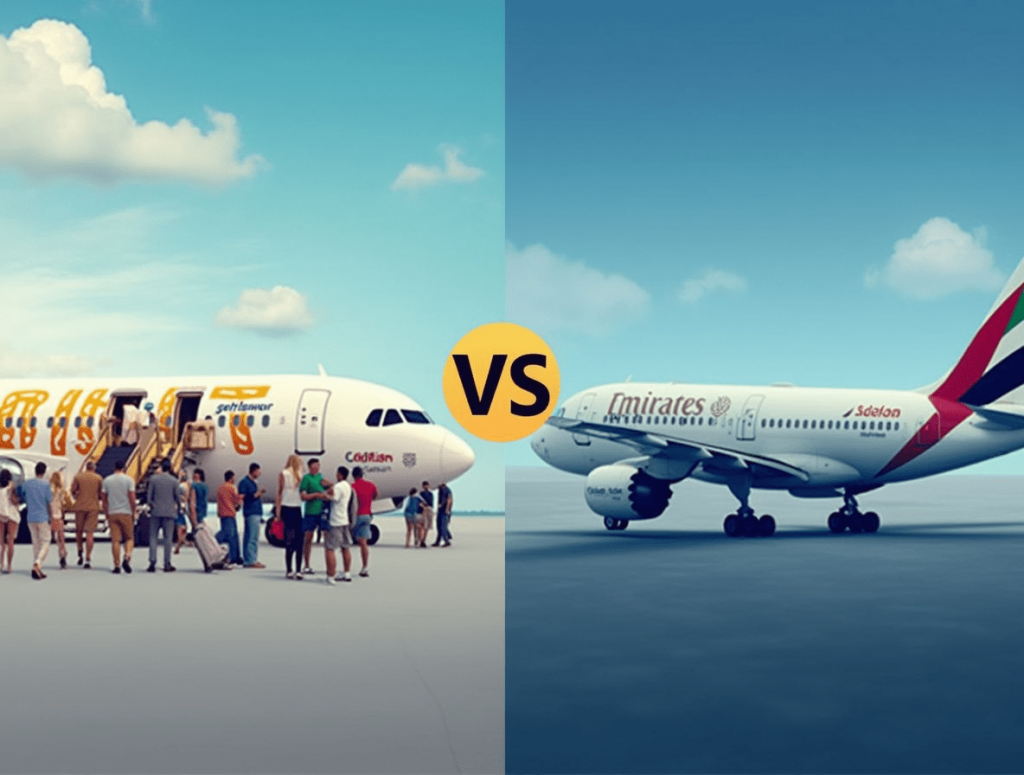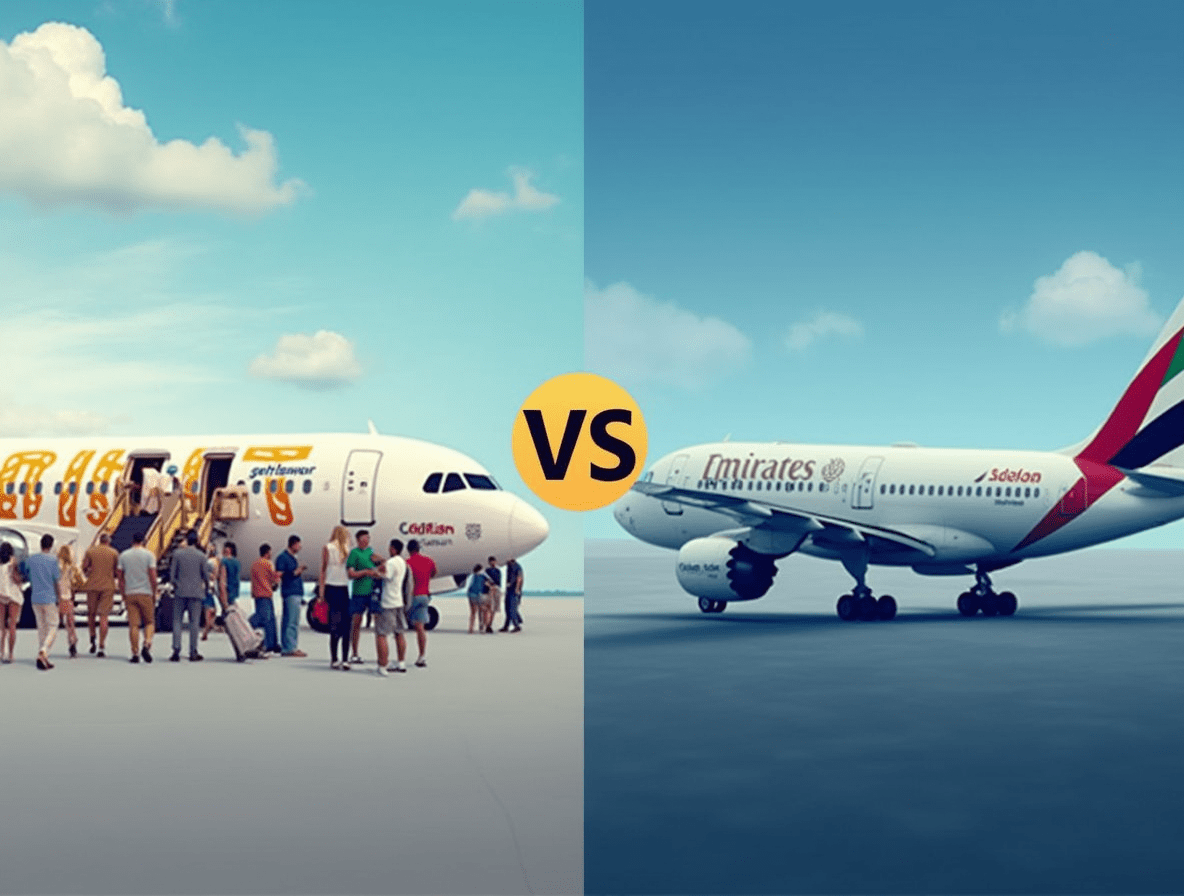
Did you know that the average traveler spends over 8 hours researching flights before booking? Despite this investment of time, 64% of travelers report feeling uncertain whether they’ve truly found the best value for their money.
The choice between budget airlines and full-service carriers represents one of the most significant decisions affecting both your travel experience and your wallet. While the price difference can be substantial—often 30-50% on identical routes—determining which option delivers superior value requires looking beyond the basic fare.
This comprehensive guide breaks down the true value equation of flying budget versus full-service airlines—analyzing not just ticket prices, but hidden costs, comfort factors, reliability metrics, and the overall travel experience—to help you make flight choices aligned with your priorities and travel needs.
Understanding Airline Business Models
What Are Budget Airlines?
Budget airlines (also called low-cost carriers or LCCs) operate on a stripped-down business model focused on minimizing operational costs to offer the lowest possible base fares.
Key characteristics include:
- Unbundled pricing structure (pay separately for each service)
- High-density seating configurations
- Use of secondary airports
- Rapid turnaround times
- Limited complementary services
- Single aircraft type fleets
- Direct sales focus (eliminating travel agent commissions)
Popular budget airlines include Southwest, Ryanair, easyJet, Spirit, Frontier, and AirAsia.
What Are Full-Service Airlines?
Full-service carriers (also called legacy or network airlines) operate on a more comprehensive model that bundles various services into the ticket price.
Key characteristics include:
- Inclusive pricing structure
- Multiple service classes (economy, premium economy, business, first)
- Hub-and-spoke route networks
- Interline/codeshare agreements with partner airlines
- Alliance memberships
- Comprehensive frequent flyer programs
- Diverse aircraft fleets
Major full-service airlines include Delta, United, American, British Airways, Lufthansa, and Singapore Airlines.
Price Comparison: Beyond the Base Fare
Base Ticket Prices
The most obvious difference between these airline types is the initial ticket price:
Budget Airlines
- Average short-haul base fares: $39-$99
- Average medium-haul base fares: $99-$199
- Average long-haul base fares (where available): $199-$399
Budget airlines typically offer their lowest fares 4-10 weeks before departure and raise prices significantly as the travel date approaches.
Full-Service Airlines
- Average short-haul base fares: $99-$249
- Average medium-haul base fares: $199-$399
- Average long-haul base fares: $499-$1,200+
Full-service airlines often maintain more stable pricing curves, though they also employ dynamic pricing models that increase as flights fill up.
According to fare analysis data, budget airlines offer base fares that average 45% lower than comparable full-service routes, with the gap narrowing to 25-30% during sales periods.
Additional Fees and Hidden Costs
The true price comparison requires factoring in supplementary fees:
Budget Airline Common Fees
- Checked baggage: $25-$65 per bag each way
- Carry-on baggage (some airlines): $25-$45 each way
- Seat selection: $5-$50 depending on location
- Priority boarding: $15-$25
- In-flight refreshments: $3-$15 per item
- Printing boarding passes at airport: $5-$20
- Flight change fees: $50-$150
- Call center booking fees: $15-$35
Full-Service Airline Common Fees
- Checked baggage (often 1 free on international): $0-$35 first bag
- Premium seat selection: $15-$129
- Extra legroom seats: $50-$180
- Same-day flight changes: $75-$150
- Alcoholic beverages (economy): $8-$15
A 2024 analysis found that once all fees are included, a budget airline ticket can increase by 35-120% from the advertised base fare, while full-service tickets typically increase by 5-30%.
Real-World Price Scenarios
To illustrate the total price difference, consider these common scenarios:
Weekend Getaway (Individual Traveler)
- Budget Airline: $79 base fare + $70 roundtrip baggage + $24 seat selection = $173
- Full-Service Airline: $189 base fare (includes baggage and standard seat) = $189
- Price difference: 8.5% (much smaller than base fare comparison)
Family Vacation (Family of Four)
- Budget Airline: $99 × 4 base fares + $280 baggage fees + $120 seat selection = $796
- Full-Service Airline: $249 × 4 base fares (includes baggage and standard seats) = $996
- Price difference: 20% (significant savings with budget option)
Business Trip (Individual with Flexible Corporate Policy)
- Budget Airline: $149 base fare + $70 baggage + $50 priority/better seat = $269
- Full-Service Airline: $329 base fare (includes benefits) = $329
- Price difference: 18% (moderate savings with budget option)
These examples demonstrate that the value proposition varies significantly based on:
- Number of travelers
- Baggage requirements
- Flexibility needs
- Desired comfort level
Comfort and Experience Factors
The price difference buys tangible differences in the travel experience:
Aircraft and Seating
Budget Airlines
- Seat pitch (legroom): 28-31 inches typically
- Seat width: 17-18 inches
- Seat recline: Limited (0-3 inches) or non-reclining
- Middle seat status: Often sold just like window/aisle
Budget airlines maximize capacity by reducing seat pitch and sometimes eliminating recline functionality. Spirit Airlines’ A320 aircraft fits 182 seats versus 150-160 on the same aircraft operated by full-service carriers.
Full-Service Airlines
- Seat pitch (economy): 31-34 inches typically
- Seat width: 17-18.5 inches
- Seat recline: Standard 4-6 inches
- Middle seat status: Sometimes blocked or sold at discount
Full-service carriers generally provide better ergonomic designs and more padding, even when physical dimensions are similar.
A 2024 passenger comfort study found that on flights over three hours, seating comfort became the #2 factor in overall satisfaction, behind only on-time performance.
Amenities and Services
Budget Airlines
- Entertainment: Usually none or paid options
- Wi-Fi: Available on select airlines/routes (fee-based)
- Food & beverages: Available for purchase
- Blankets/pillows: Available for purchase or not offered
- Customer service access: Limited, often with additional fees
Full-Service Airlines
- Entertainment: Complimentary on most medium/long-haul flights
- Wi-Fi: Increasingly available (sometimes free for messaging)
- Food & beverages: Complimentary basic options
- Blankets/pillows: Often provided on longer flights
- Customer service: Multiple channels, usually without additional fees
Full-service carriers typically offer power outlets, better entertainment options, and more comprehensive service recovery during disruptions.
Airport Experience
The airline type affects your ground experience as well:
Budget Airlines
- Airports: Often secondary locations farther from city centers
- Check-in: Strict cutoff times, less staff availability
- Lounges: Typically not available (except through third parties)
- Connections: Self-transfers, often requiring baggage re-check
- Gate assignments: Sometimes remote stands requiring bus transfers
Full-Service Airlines
- Airports: Primary hubs with better transportation connections
- Check-in: More flexible policies with dedicated counters for status members
- Lounges: Available for premium cabins and elite status holders
- Connections: Protected transfers, often with through-checked baggage
- Gate assignments: Preferential gates closer to terminals
The airport difference can add 30-90 minutes in transit time each way when using secondary airports served by budget carriers.
Reliability and Schedule Considerations
Operational reliability represents a critical but often overlooked value factor:
On-Time Performance
Contrary to popular belief, budget airlines often match or exceed full-service carriers in punctuality. According to U.S. Department of Transportation data for 2024:
- Budget airline average on-time arrival rate: 79.3%
- Full-service airline average on-time arrival rate: 81.2%
The gap has narrowed significantly in recent years, though results vary substantially by region and individual airline.
Flight Disruptions and Recovery
How airlines handle disruptions reveals more significant differences:
Budget Airlines
- Rebooking options: Limited to own flights, often with significant delays
- Compensation policies: Minimum required by regulations
- Accommodations during disruptions: Typically not provided
- Staff availability during disruptions: More limited resources
Full-Service Airlines
- Rebooking options: Partner airlines and alliances provide more alternatives
- Compensation policies: Often exceed regulatory minimums for premium customers
- Accommodations during disruptions: More likely to provide hotels/meals
- Staff assistance: More personnel available during disruptions
A 2024 passenger survey found that during significant disruptions, full-service airline customers reached their final destinations an average of 12.5 hours sooner than budget airline passengers.
Schedule Frequency and Routing
Flight schedule flexibility varies considerably:
Budget Airlines
- Flight frequency: Lower frequency on most routes (1-2 daily)
- Route structures: Primarily point-to-point
- Schedule changes: More seasonal adjustments
- Recovery from cancellations: Fewer alternative options
Full-Service Airlines
- Flight frequency: Higher frequency on business routes (3-8 daily)
- Route structures: Hub-and-spoke with connecting options
- Schedule stability: More consistent year-round service
- Recovery from cancellations: More rebooking pathways
For business travelers or those with time-sensitive plans, the schedule resilience of full-service carriers provides tangible value that may outweigh price differences.
Specific Traveler Scenarios
The value equation shifts dramatically based on traveler profiles:
Leisure Travelers
Budget Airlines Excel For:
- Weekend getaways with minimal luggage
- Family trips where total cost is the primary concern
- Destinations where secondary airports are actually convenient
- Flexible travel dates that can accommodate schedule changes
- Trips where in-flight experience is less important
Full-Service Airlines Excel For:
- Inclusive family vacations with checked baggage needs
- Complex itineraries with connections
- Destinations requiring early arrival/late departure options
- International trips where baggage allowances and meals add value
- Special occasions where experience quality matters
Business Travelers
Budget Airlines Excel For:
- Regional offices near secondary airports
- Day trips with carry-on only
- Small businesses with tight travel budgets
- Non-critical meetings with flexible timing
- Routes where budget airlines offer superior timing
Full-Service Airlines Excel For:
- Last-minute booking needs
- International business requiring multiple connections
- Client-facing travel where impressions matter
- Companies with negotiated corporate rates
- Travelers needing productivity tools (Wi-Fi, power, workspace)
Special Needs Travelers
Full-service carriers consistently deliver better value for travelers with:
- Mobility limitations requiring assistance
- Medical conditions requiring accommodations
- Young children traveling alone
- Senior travelers needing extra support
- Passengers requiring extra space
These travelers benefit from the more comprehensive service infrastructure and training programs of full-service airlines.
Total Value Assessment Framework
To evaluate which airline type delivers better value for your specific situation, consider this weighted framework:
Value Factors and Typical Weightings
- Total trip cost (including all fees) – 30% Calculate the absolute final price including every potential charge.
- Time value factors – 25% Airport locations, schedule options, on-time performance, and potential disruption impacts.
- Comfort requirements – 20% Seat dimensions, amenities, and services relevant to your flight length.
- Flexibility needs – 15% Change/cancellation policies and rebooking options.
- Loyalty program value – 10% Relevant for frequent travelers on consistent routes.
Sample Value Calculations
Short Domestic Trip (2-hour flight)
- Budget airline score: 82/100 (strong value proposition)
- Full-service airline score: 64/100 (lower value for short trips)
International Long-Haul Trip (8+ hours)
- Budget airline score: 61/100 (diminishing value over longer flights)
- Full-service airline score: 79/100 (stronger value for longer durations)
Regular Business Commuter Route
- Budget airline score: 70/100 (good for predictable, simple trips)
- Full-service airline score: 76/100 (better when considering frequency and flexibility)
Industry Trends Affecting Value
Several current aviation industry trends are reshaping the value equation:
Convergence of Business Models
Traditional distinctions between airline types are blurring:
- Budget airlines adding premium options (priority boarding, extra legroom sections)
- Full-service carriers adopting basic economy fares with unbundled approaches
- Both types investing in newer, more efficient aircraft
- Technology standardization across the industry
This convergence has narrowed some historical value gaps while creating more complex decision matrices for consumers.
Sustainability Considerations
Environmental impact is becoming a value factor for many travelers:
- Newer fleets (often found at budget airlines) typically produce lower emissions per passenger
- Full-service airlines generally invest more in sustainable aviation fuel initiatives
- Carbon offset programs more commonly offered by full-service carriers
- Higher density seating in budget airlines reduces per-passenger carbon footprint
A 2024 environmental impact study found that budget airlines produced 5-12% lower emissions per passenger-mile due to higher seat density and more efficient fleet utilization.
Technology Enhancements
Digital tools are improving experiences across airline types:
- Mobile check-in and digital boarding passes standard across both models
- Self-service baggage systems reducing airport time differences
- Flight status notifications reducing uncertainty during disruptions
- Seat mapping tools helping passengers make informed decisions
These technologies have particularly benefited budget travelers by streamlining processes that historically favored full-service customers.
Conclusion: Which Offers Better Value?
The value comparison between budget and full-service airlines doesn’t yield a universal answer. Instead, the better value option depends on:
- Specific route characteristics and competition
- Your particular travel needs and preferences
- Trip duration and complexity
- Number of travelers in your party
- Baggage requirements
- Schedule sensitivity
Budget airlines typically deliver superior value for:
- Direct, short-to-medium flights (under 4 hours)
- Travelers with minimal baggage needs
- Flexible schedules without tight connections
- Price-sensitive travel where total cost is paramount
- Regions with convenient secondary airports
Full-service airlines generally provide better value for:
- Long-haul international travel
- Complex itineraries with connections
- Business travelers with schedule constraints
- Passengers with special assistance needs
- Travelers prioritizing comfort on longer flights
The most value-conscious approach often involves using both airline types strategically:
- Budget carriers for simple point-to-point domestic trips
- Full-service airlines for complex international journeys
- Mixed itineraries leveraging the strengths of each
As airline business models continue evolving, staying informed about pricing structures, loyalty programs, and service offerings becomes increasingly important for identifying the best value opportunities. When evaluating options, look beyond the base fare to calculate the true cost of your complete travel experience.
FAQ Section
How far in advance should I book to get the best value?
For budget airlines, booking 4-10 weeks ahead typically yields the best prices. Full-service carriers often release their lowest fares 3-6 months in advance for international flights and 1-3 months for domestic routes. However, last-minute deals occasionally appear on full-service airlines to fill unsold premium seats, while budget carriers rarely discount close to departure.
Do budget airlines have worse safety records?
No. Budget airlines maintain safety standards equivalent to full-service carriers, as they must meet the same regulatory requirements. Many budget airlines operate newer fleets than their legacy counterparts, potentially offering safety advantages from modern aircraft technology. Aviation authorities consistently confirm no statistical safety difference between airline business models.
How do loyalty programs compare between airline types?
Full-service airline loyalty programs typically offer more comprehensive benefits including lounge access, priority services, alliance-wide recognition, and better upgrade opportunities. Budget airline programs generally focus on simpler earn-and-burn models with flight credits or limited redemption options. Frequent travelers on specific routes may extract more value from full-service programs, while occasional travelers might find budget airline rewards more accessible.
Are premium seats on budget airlines comparable to full-service?
Premium offerings on budget airlines (like Spirit’s Big Front Seat or Frontier’s Stretch seating) typically provide extra legroom and width comparable to premium economy on full-service carriers but lack the additional service elements. These options offer good value when you need physical space but don’t require enhanced cabin service, often at 30-50% lower prices than true premium economy products.
What about reliability during weather disruptions?
Full-service carriers generally demonstrate better recovery from major weather events due to their larger networks, interline agreements, and greater staff resources. Budget airlines typically prioritize maintaining their regular schedule over accommodating disrupted passengers, resulting in longer average recovery times. If traveling during storm seasons or to weather-volatile regions, this reliability difference may significantly impact the overall value equation.













